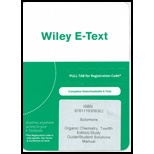
Interpretation:
The structure of codling moth sex pheromone is to be given with the help of given information.
Concept Introduction:
Electrophiles are electron deficient species which has positive or partially positive charge. Lewis acids are electrophiles which accept electron pair.
Nucleophiles are electron rich species which has negative or partially negative charge. Lewis bases are nucleophiles which donate electron pair.
Free radical is an atom, molecule or ion that has unpaired electrons which makes it highly chemically reactive.
Substitution reaction: A reaction in which one of the hydrogen atoms of a hydrocarbon or a
Elimination reaction: A reaction in which two substituent groups are detached and a double bond is formed is called elimination reaction.
Addition reaction: It is the reaction in which unsaturated bonds are converted to saturated molecules by the addition of molecules.
The reaction in which hydrogen is added to the compound in the presence of catalyst is known as hydrogenation.
The number of moles of hydrogen absorbed will be equal to the number of double bonds.
Reduction is a process in which hydrogen atoms are added to a compound. Usual reagents used in the reduction process are
The reaction in which the
Reduction is a process in which the addition of hydrogen atoms to a compound takes place.
During an addition reaction unsaturated bonds are converted into saturated molecules by the addition of molecules
Ozonolysis is a process in which the given alkene is cleaved with ozone
The
First, give priority according to Cahn-Ingold-Prelog convention rules:
The higher the
If priority cannot be assigned according to atomic mass, then assign the priority according to the first point of difference.
If both the priority groups are on the same side of a double-bonded carbon atom, then it is known as
But if both the priority groups are diagonal to each other, then it is
Want to see the full answer?
Check out a sample textbook solution
Chapter 8 Solutions
ORGANIC CHEMISTRY-ETEXT REG ACCESS
- Classify each amino acid below as nonpolar, polar neutral, polar acidic, or polar basic.arrow_forwarddraw skeletal structures for the minor products of the reaction.arrow_forward1. Provide missing starting materials, reagents, products. If a product cannot be made, write NP (not possible) in the starting material box. C7H12O Ph HO H 1) 03-78 C 2) Me₂S + Ph .H OH + 2nd stereoisomer OH Ph D + enantiomer cat OsO 4 NMO H2O acetonearrow_forward
- Please note that it is correct and explains it rightly:Indicate the correct option. The proportion of O, C and H in the graphite oxide is:a) Constant, for the quantities of functional groups of acids, phenols, epoxy, etc. its constants.b) Depending on the preparation method, as much oxidant as the graphite is destroyed and it has less oxygen.c) Depends on the structure of the graphic being processed, whether it can be more tridimensional or with larger crystals, or with smaller crystals and with more edges.arrow_forwardCheck the box under each a amino acid. If there are no a amino acids at all, check the "none of them" box under the table. Note for advanced students: don't assume every amino acid shown must be found in nature. ནང་་་ OH HO HO NH2 + NH3 O OIL H-C-CO CH3-CH O C=O COOH COOH + H2N C-H O H2N C H CH3-CH CH2 HO H3N O none of them 口 CH3 CH2 OH Хarrow_forwardWhat is the systematic name of the product P of this chemical reaction? 010 HO-CH2-CH2-C-OH ☐ + NaOH P+ H2Oarrow_forward
- 1. Provide missing starting materials, reagents, products. If a product cannot be made, write NP (not possible) in the starting material box. a) C10H12 Ph OMe AcOHg+ + enantiomer Br C6H10O2 + enantiomerarrow_forwardDraw the Fischer projection of the most common naturally-occurring form of cysteine, with the acid group at the top and the side chain at the bottom. Important: be sure your structure shows the molecule as it would exist at physiological pH. Click and drag to start drawing a structure. :☐ ©arrow_forwardDraw an a amino acid with an ethyl (-CH2-CH3) side chain. Draw the molecule as it would appear at physiological pH. Click and drag to start drawing a structure. :□ S टेarrow_forward
- Write the systematic name of each organic molecule: HO Cl structure O OH O HO OH name ☐ OH OH ☐ OH ☐arrow_forwardWrite the name of a naturally-occuring hydrophillic amino acid. (You will find the structures of the naturally-occuring amino acids in the ALEKS Data resource.) × $arrow_forwardPlease note that it is correct and explains it rightly:The proportion of O, C and H in the graphite oxide is:a) Constant, for the quantities of functional groups of acids, phenols, epoxy, etc. its constantsb) Depending on the preparation method, as much oxidant as the graphite is destroyed and it has less oxygenc) Depends on the structure of the graphic being processed, whether it can be more three-dimensional or with larger crystals, or with smaller crystals and more borders.arrow_forward

 Organic ChemistryChemistryISBN:9781305580350Author:William H. Brown, Brent L. Iverson, Eric Anslyn, Christopher S. FootePublisher:Cengage Learning
Organic ChemistryChemistryISBN:9781305580350Author:William H. Brown, Brent L. Iverson, Eric Anslyn, Christopher S. FootePublisher:Cengage Learning Introduction to General, Organic and BiochemistryChemistryISBN:9781285869759Author:Frederick A. Bettelheim, William H. Brown, Mary K. Campbell, Shawn O. Farrell, Omar TorresPublisher:Cengage Learning
Introduction to General, Organic and BiochemistryChemistryISBN:9781285869759Author:Frederick A. Bettelheim, William H. Brown, Mary K. Campbell, Shawn O. Farrell, Omar TorresPublisher:Cengage Learning


